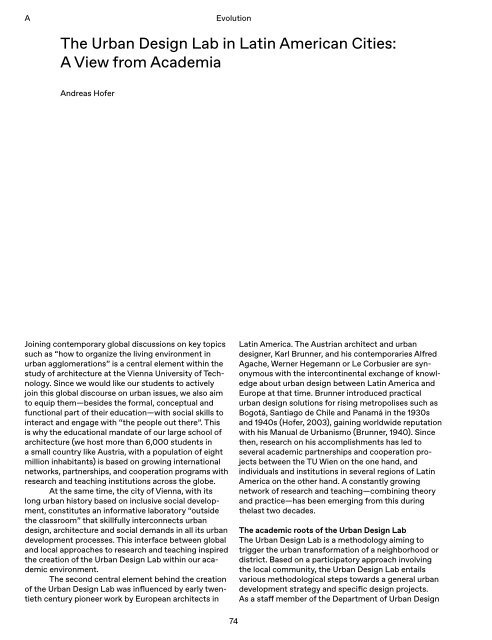Urban Design Lab Handbook – Dialogue-oriented urban transformation processes and practical approaches from Latin America and the Caribbean
ISBN 978-3-86859-562-8 https://www.jovis.de/en/books/preview/product/urban-design-lab-handbook.html
ISBN 978-3-86859-562-8
https://www.jovis.de/en/books/preview/product/urban-design-lab-handbook.html
You also want an ePaper? Increase the reach of your titles
YUMPU automatically turns print PDFs into web optimized ePapers that Google loves.
A<br />
Evolution<br />
The <strong>Urban</strong> <strong>Design</strong> <strong>Lab</strong> in <strong>Latin</strong> <strong>America</strong>n Cities:<br />
A View <strong>from</strong> Academia<br />
Andreas Hofer<br />
Joining contemporary global discussions on key topics<br />
such as “how to organize <strong>the</strong> living environment in<br />
<strong>urban</strong> agglomerations” is a central element within <strong>the</strong><br />
study of architecture at <strong>the</strong> Vienna University of Technology.<br />
Since we would like our students to actively<br />
join this global discourse on <strong>urban</strong> issues, we also aim<br />
to equip <strong>the</strong>m—besides <strong>the</strong> formal, conceptual <strong>and</strong><br />
functional part of <strong>the</strong>ir education—with social skills to<br />
interact <strong>and</strong> engage with “<strong>the</strong> people out <strong>the</strong>re”. This<br />
is why <strong>the</strong> educational m<strong>and</strong>ate of our large school of<br />
architecture (we host more than 6,000 students in<br />
a small country like Austria, with a population of eight<br />
million inhabitants) is based on growing international<br />
networks, partnerships, <strong>and</strong> cooperation programs with<br />
research <strong>and</strong> teaching institutions across <strong>the</strong> globe.<br />
At <strong>the</strong> same time, <strong>the</strong> city of Vienna, with its<br />
long <strong>urban</strong> history based on inclusive social development,<br />
constitutes an informative laboratory “outside<br />
<strong>the</strong> classroom” that skillfully interconnects <strong>urban</strong><br />
design, architecture <strong>and</strong> social dem<strong>and</strong>s in all its <strong>urban</strong><br />
development <strong>processes</strong>. This interface between global<br />
<strong>and</strong> local <strong>approaches</strong> to research <strong>and</strong> teaching inspired<br />
<strong>the</strong> creation of <strong>the</strong> <strong>Urban</strong> <strong>Design</strong> <strong>Lab</strong> within our academic<br />
environment.<br />
The second central element behind <strong>the</strong> creation<br />
of <strong>the</strong> <strong>Urban</strong> <strong>Design</strong> <strong>Lab</strong> was influenced by early twentieth<br />
century pioneer work by European architects in<br />
<strong>Latin</strong> <strong>America</strong>. The Austrian architect <strong>and</strong> <strong>urban</strong><br />
designer, Karl Brunner, <strong>and</strong> his contemporaries Alfred<br />
Agache, Werner Hegemann or Le Corbusier are synonymous<br />
with <strong>the</strong> intercontinental exchange of knowledge<br />
about <strong>urban</strong> design between <strong>Latin</strong> <strong>America</strong> <strong>and</strong><br />
Europe at that time. Brunner introduced <strong>practical</strong><br />
<strong>urban</strong> design solutions for rising metropolises such as<br />
Bogotá, Santiago de Chile <strong>and</strong> Panamá in <strong>the</strong> 1930s<br />
<strong>and</strong> 1940s (Hofer, 2003), gaining worldwide reputation<br />
with his Manual de <strong>Urban</strong>ismo (Brunner, 1940). Since<br />
<strong>the</strong>n, research on his accomplishments has led to<br />
several academic partnerships <strong>and</strong> cooperation projects<br />
between <strong>the</strong> TU Wien on <strong>the</strong> one h<strong>and</strong>, <strong>and</strong><br />
individuals <strong>and</strong> institutions in several regions of <strong>Latin</strong><br />
<strong>America</strong> on <strong>the</strong> o<strong>the</strong>r h<strong>and</strong>. A constantly growing<br />
network of research <strong>and</strong> teaching—combining <strong>the</strong>ory<br />
<strong>and</strong> practice—has been emerging <strong>from</strong> this during<br />
<strong>the</strong>last two decades.<br />
The academic roots of <strong>the</strong> <strong>Urban</strong> <strong>Design</strong> <strong>Lab</strong><br />
The <strong>Urban</strong> <strong>Design</strong> <strong>Lab</strong> is a methodology aiming to<br />
trigger <strong>the</strong> <strong>urban</strong> <strong>transformation</strong> of a neighborhood or<br />
district. Based on a participatory approach involving<br />
<strong>the</strong> local community, <strong>the</strong> <strong>Urban</strong> <strong>Design</strong> <strong>Lab</strong> entails<br />
various methodological steps towards a general <strong>urban</strong><br />
development strategy <strong>and</strong> specific design projects.<br />
As a staff member of <strong>the</strong> Department of <strong>Urban</strong> <strong>Design</strong><br />
74


















